General safety information and caution
| General Safety Information and Caution |
| 1. | Be careful when driving the vehicle using the smart cruise control system as follows. | (1) | On curves or inclines/declines | •
| The smart cruise control system may have limits to detect distance to the vehicle ahead due to road and traffic conditions. |
| •
| On curves or inclines/declines, the smart cruise control system may not detect a moving vehicle in your lane, and then your vehicle may accelerate to the set speed directly. Also, the vehicle speed may slow down abruptly when the vehicle ahead is recognized. Select the appropriate set speed on curves or inclines/declines and control the vehicle speed by applying the brake pedal if necessary. 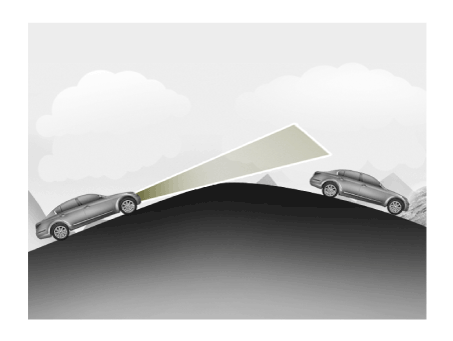
|
| •
| Your vehicle speed can be reduced due to a vehicle in the adjacent lane. Apply the accelerator pedal and select the appropriate set speed. Check to be sure that the road conditions permit. 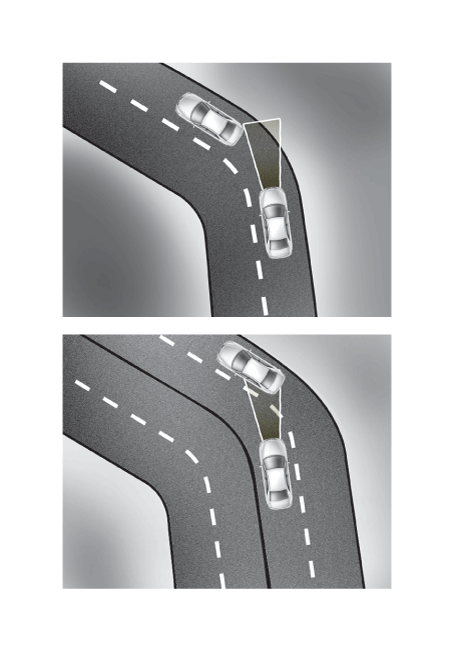
|
|
| (2) | Lane changing | •
| A vehicle which moves into your lane from an adjacent lane cannot be recognized by the sensor until it is in the sensor's detection range. |
| •
| Be always cautious because a vehicle which suddenly moves into your lane can be recognized late by the sensor. |
| •
| If the vehicle which moves into your lane is slower than your vehicle, the speed may decrease to maintain the distance to the vehicle ahead. |
| •
| If the vehicle which moves into your lane is faster than your vehicle, your vehicle will maintain the selected speed even the vehicle is in the sensor's detection range. 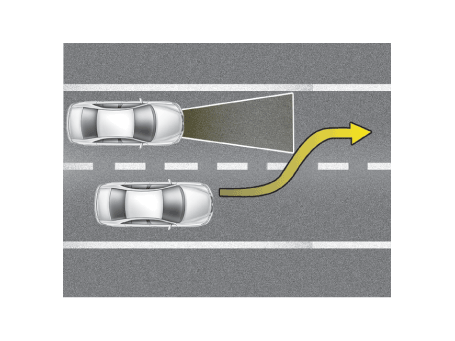
|
|
| •
| Even though a vehicle is in the same lane, a vehicle which is out of the sensor’s detection range cannot be recognized by the sensor. |
| –
| Small vehicle such as motorcycle, bicycle and cultivator |
| –
| A vehicle offset to one side |
| –
| A slow-moving vehicle or sudden-decelerating vehicle |
| –
| A vehicle with small rear profile such as trailer with no loads |
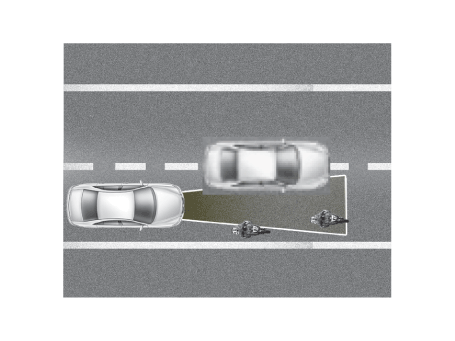
|
| 2. | In this following situation, the front vehicle can’t be recognized correctly so control the vehicle speed by applying the brake pedal or accelerator pedal if necessary. | (1) | When the vehicle is pointing upwards due to overloading in the trunk |
| (2) | While making turns by steering |
| (3) | When driving to one side of the lane |
| (4) | When driving on narrow lanes or on curves |
|
| 3. | If the smart cruise control is left on (CRUISE indicator light ON), the smart cruise control can be switched on accidentally. Keep the smart cruise control system off (CRUISE indicator light OFF) when the smart cruise control is not in use, to avoid inadvertently setting a speed. |
| 4. | Observe a regulation speed on road when setting the cruise speed. |
| 5. | Use the smart cruise control system only when traveling on open highways in good weather. Do not use the smart cruise control when it may not be safe to keep the car at a constant speed, for instance, driving in heavy or varying traffic, or on slippery (rainy, icy or snow-covered) or winding roads or over 6% up-hill or down-hill roads. |
| 6. | Pay particular attention to the driving conditions whenever using the smart cruise control system. |
| 7. | The vehicle cannot be stopped by using the smart cruise control system. If emergency stop is necessary, you should apply the brakes. |
| 8. | Keep the safety distance according to road conditions and vehicle speed. If the following distance is too close at a high speed driving, it is dangerous. |
| 9. | The smart cruise control system can not recognize a stopped vehicle, pedestrians or an oncoming vehicle. Always look ahead cautiously to prevent unexpected and sudden situations from occurring. |
| 10. | The smart cruise control system is not a substitute for safe driving practices but a supplementary function only. It is the responsibility of the driver to always check the speed and the distance to the vehicle ahead. |
| 11. | In front of you, vehicles moving with a frequent lane change may cause a delay in the system's reaction or may cause the system to react to a vehicle actually in adjacent lane. Always look ahead cautiously to prevent unexpected and sudden situations from occurring. |
| 12. | Your vehicle may accelerate when a vehicle ahead of you disappears. When you are warned that the vehicle ahead of you is not detected, drive with caution. 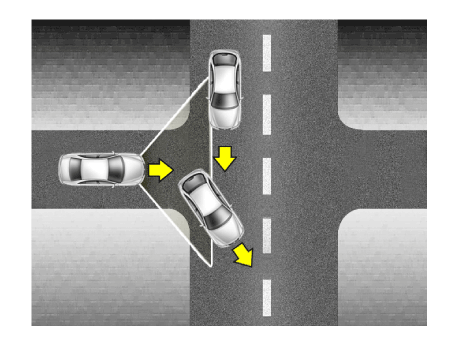
|
| 13. | When vehicles are at a standstill and the vehicle in front of you changes to the next lane, be careful when your vehicle starts to move because it may not recognize the stopped vehicle in front of you. 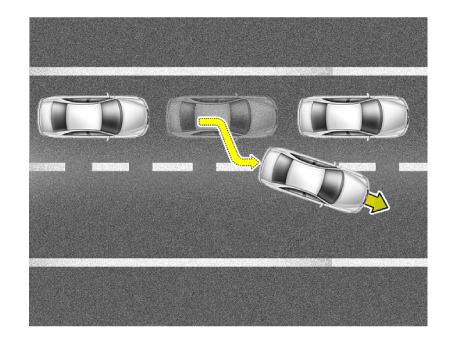
|
| 14. | Always look out for pedestrians when your vehicle is maintaining a distance with the vehicle ahead. 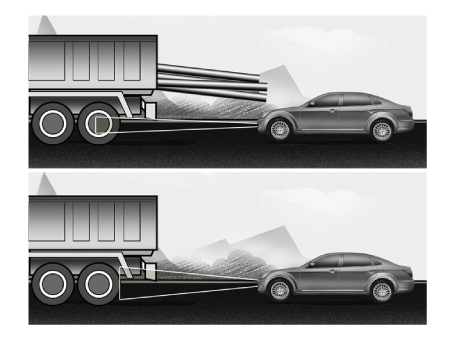
|
| 15. | Always be cautious for vehicles with higher height or vehicles carrying loads that sticks out to the back of the vehicle. 
|
Description and operation
| Description and operation |
The System may be limited when | •
| The radar sensor or camera is blocked with a foreign object or debris. |
| •
| The camera lens is contaminated due to tinted filmed or coated windshield, damaged glass, or stuck of foreign matter (sticker, bug, etc.) on the glass. |
| •
| Inclement weather such as heavy rain or snow obscures the field of view of the radar sensor or camera. |
| •
| The target in front is too small to be detected. |
| •
| The vehicle in front is an oversize vehicle or trailer that is too big to be detected by the camera recognition system (for example a tractor trailer, etc.). |
| •
| The camera's field of view is not well illuminated (either too dark or too much reflection or too much backlight that obscures the field of view) |
| •
| The vehicle in front does not have their rear lights ON or their rear lights are located in an unusual location (modified). |
| •
| The windshield glass is fogged up and the clear view of the road has been obstructed. |
| •
| The camera or radar is damaged. |
|
System Flow
| A Type (Front rader none apply) |

| B Type (Front rader apply) |
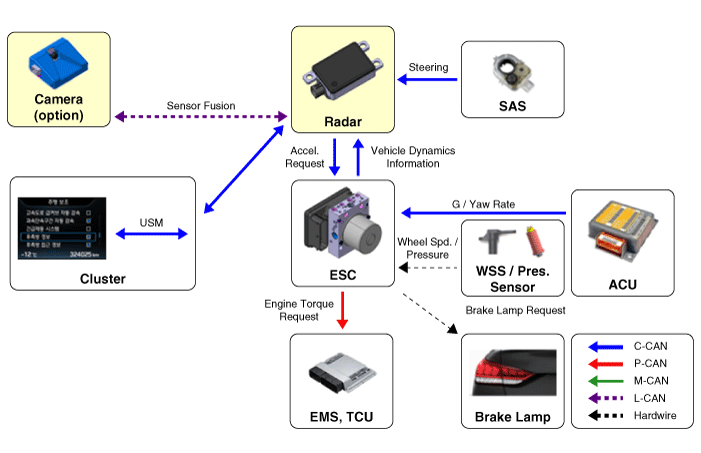
| •
| Rader, Camera : Detection device (radar and camera) that can recognize potential obstacles in the front. |
| •
| Cluster : Human-Machine Interface (HMI) to warn driver or change settings. |
| •
| ESC : Braking system to automatically brake the car |
| •
| Sensors : FCA, contrary to FCA (Smart Cruise Control), has to work on a stationary car so the system uses the Fusion Target system to combine radar with camera. |
|
System description
The smart cruise control system allows a driver to program the vehicle to control the speed and following distance detecting the vehicle ahead without depressing the brake pedal and the accelerator pedal.
| 1. | FCA : Forward Collision-avoidance Assist | (1) | FCA system is designed to help avoid a potential collision or reduce its impact when drivers applies inadequate, delayed or no brakes at all to avoid a collision. |
| (2) | The system detects the risk factors on the road by using the frontal impact sensor and warn the driver and activate the emergency brake to prevent collision or reduce collision speed. |
|
| 2. | SCC : Smart Cruise Control | (1) | Cruise speed control : The vehicle maintains the selected speed if there are not vehicles ahead. |
| (2) | Retardation control : The vehicle decelerates if a vehicle ahead is detected. |
| (3) | Following distance control : The vehicle maintains the selected following distance. |
| (4) | Acceleration control : The vehicle accelerates to the selected speed if a vehicle ahead is not detected. 
|
|
System function
| 1. | Control on curves | (1) | The sensor may not detect a vehicle ahead or may detect a vehicle on other lanes because the detection range of the sensor is limited. |
| (2) | On curves, if the vehicle equipped the SCC is driving at high speed, the vehicle can slip outside. Therefore reduce the speed on curves even there is not a vehicle ahead. (There is no brake control by SCC.) |
| (3) | While the vehicle follows a vehicle ahead on straight road, if the vehicle ahead enters on curve, the vehicle equipped the SCC may accelerate to follow the vehicle ahead. |
| (4) | On curves, if a vehicle ahead followed is out of range, the vehicle does not accelerate to the set speed and maintain the following speed to prevent from accelerating and decelerating repeatedly. (If the vehicle equipped the SCC changes the lane or apply the accelerator pedal, the vehicle will accelerate.) |
|
| 2. | Warning alarm If the vehicle equipped the SCC decelerates because a vehicle ahead decelerates or moves into your lane, the warning will operate. | (1) | In case that the vehicle equipped with SCC is able to decelerate properly by the system – No warning |
| (2) | In case that the vehicle equipped with SCC is not able to decelerate properly by the system | –
| Indicator in the cluster will blink and the warning buzzer will sound. (The warning and deceleration by the system will go on until the brake pedal is applied.) |
|
| (3) | If the vehicle ahead (vehicle speed: less than 30km/h) disappears to the next lane during following distance control, the warning chime will sound and a message will appear. Adjust your vehicle speed for vehicles or objects that can suddenly appear in front of you. |
|
| 3. | Accelerating by driver Even the vehicle is being decelerated by the SCC system, the vehicle can be accelerated by applying the accelerator pedal. If the vehicle is accelerated above the set speed, the indicator in the cluster will blink. |
| 4. | Function of cruise control | (1) | The driver may choose to only use the cruise control mode (speed control function) by doing as follows: |
| (2) | With the smart cruise control system on (the cruise indicator light will be on but the system will not be activated), push the distance to distance switch for more than 2 seconds. "Smart cruise control (SCC) mode" and "Cruise control (CC) mode" can be selected.The speed control of the cruise control mode is the same as that of the smart cruise control mode. |
| (3) | When using the cruise control mode, the driver must manually access the distance to other vehicles as the system will not automatically brake to slow down for other vehicles. |
|
| 5. | Autonomous Emergency Braking function | (1) | It is a driving convenience system that controls the steering and speed to keep the safe distance from the vehicle ahead and to prevent lane departure on highway while Smart Cruise Control is operating. |
|
| 6. | Highway Driving Assist (HDA) function | (1) | It is a driving convenience system that controls the steering and speed to keep the safe distance from the vehicle ahead and to prevent lane departure on highway while Smart Cruise Control is operating. |
|
System Operation
FCA : Forward Collision-avoidance Assist)
| 1. | Basic specification (front camera applied) 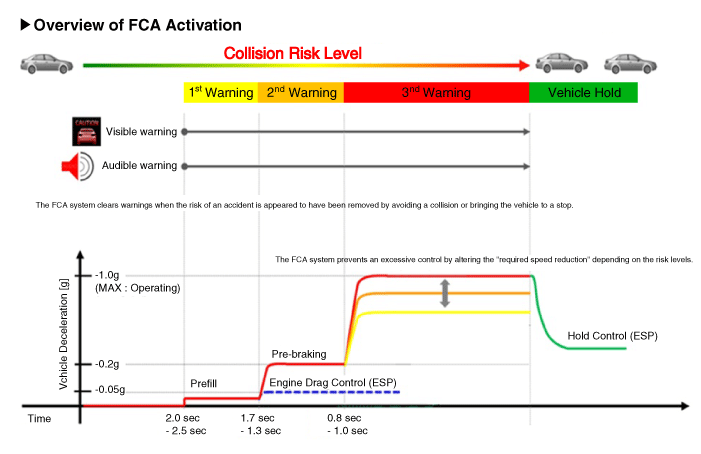
※ The time indicated will be changed according to vehicle speeds. | •
| Step 1 : Issue a visual (display) and vocal alarm when a danger is detected. |
| •
| Step 2 : Reduce engine torque and activates FCA when there is a high chance of collision. |
| •
| Step 3 : Activate emergency brake when a collision is imminent. |
| •
| After stopping the vehicle : Maintain the braking control for a certain time and then release it. |
| •
| Braking power is adjusted depending on the risk levels of collision, but it is released immediately when it detects the driver's action to avoid a collision. |
| 1) | When it exceeded the maximum operation speed. |
| 2) | When it detected driver's action to avoid a collision such as sudden steering changes. |
| 3) | When the shift lever is in R or P |
| 4) | When you pressed the accelerator pedal half way. |
|
| 1) | When you drive at 60km/h - 180km/h or faster, the system does not go to step 3 of emergency braking. - Full auto braking is not available. |
| 2) | When you drive at 60km/h or faster, the system does not go to step 3 of emergency braking. - But a collision may occur at depending on the road conditions. |
| 3) | Offset should be less than 50%. |
| 4) | FCA does not work on the vehicles backing up or resisting. |
|
Offset : Rate of non-overlapping on the line between the front driving car and my car | 1) | Offset 0% : 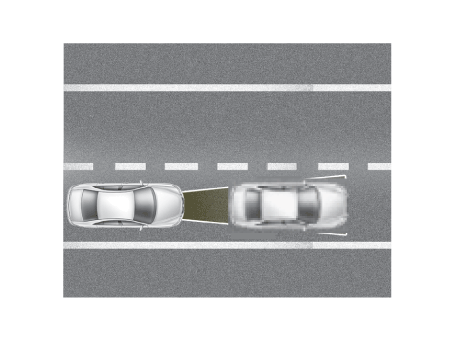
|
| 2) | Offset 100% : 
|
|
|
| 2. | When the Smart Cruise Control is applied at the same time (front radar added) 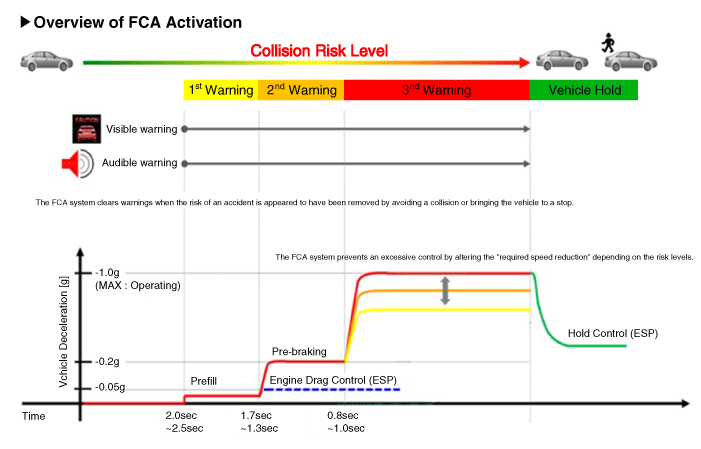
The time indicated will be changed according to vehicle speeds. | •
| Step 1 : Issue a visual (display) and vocal alarm when a danger is detected. |
| •
| Step 2 : Reduce engine torque and activates FCA when there is a high chance of collision. |
| •
| Step 3 : Activate emergency brake when a collision is imminent. |
| •
| After stopping the vehicle : Maintain the braking control for a certain time and then release it. |
| •
| Braking power is adjusted depending on the risk levels of collision, but it is released immediately when it detects the driver's action to avoid a collision. |
| 1) | When it exceeded the maximum operation speed. |
| 2) | When it detected driver's action to avoid a collision such as sudden steering changes. |
| 3) | When the shift lever is in R or P |
| 4) | When you pressed the accelerator pedal half way. |
|
| 1) | When you drive at 85km/h - 180km/h or faster, the system does not go to step 2 of emergency braking. - Full auto braking is not available. |
| 2) | When you drive at 85km/h or faster, the system does not go to step 3 of emergency braking. - But a collision may occur at depending on the road conditions. - Partial braking may be applied according to the surrounding environment. - For the vehicle parked in front, full braking is applied at level 3 after the warning only when the vehicle speed is under 75 km/h. Up to level 2 is performed when the vehicle speed is over 75 km/h. - For the pedestrian and cyclists, full braking is applied at level 3 after the warning only when the vehicle speed is under 65 km/h. Up to level 1 is performed when the vehicle speed is over 65 km/h. |
| 3) | Offset should be less than 50%. |
| 4) | FCA does not work on the vehicles backing up or resisting. |
|
Offset : Rate of non-overlapping on the line between the front driving car and my car | 1) | Offset 0% : 
|
| 2) | Offset 100% : 
|
|
|
SCC : Smart Cruise Control
| 1. | Smart cruise control operating mode. 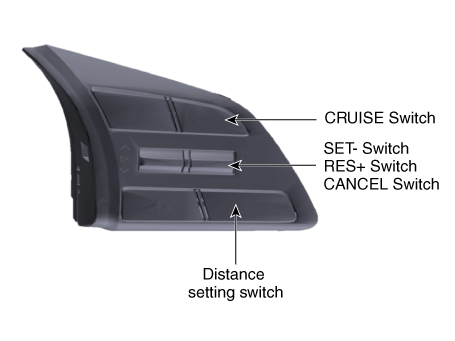
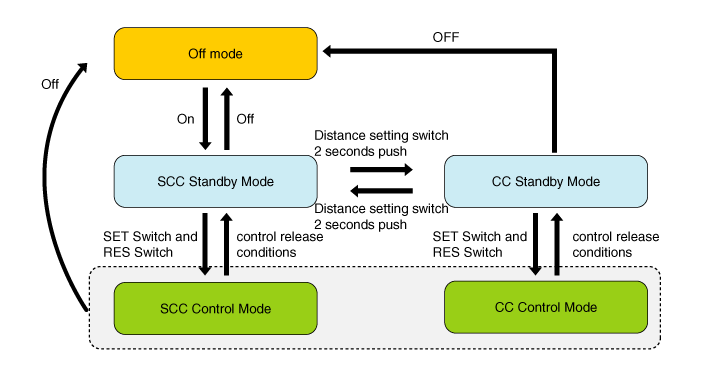
| •
| SCC : Smart Cruise Control |
|
|
| 2. | Smart cruise control operating conditions. | (1) | Vehicle speed at approximately 0-160km/h (0-99.4mph) |
| (2) | Transmission in D or Sports mode |
| (4) | "CRUISE" switch ON (CRUISE indicator ON) |
|
| 3. | Smart cruise control disabling conditions | (5) | Vehicle speed at more than approximately 160km/h (99.4mph) |
| (6) | Vehicle speed at less than approximately 10km/h (5mph) |
| (7) | Transmission in N or P or R |
| (8) | ESP/ TCS / ABS certain period of time operating |
| (9) | An accelerator pedal applied for more than 5min |
| (10) | ESP OFF" switch ON (ESP OFF indicator ON) |
| (11) | Parking brake applied |
| (12) | System failure (The warning indicator ON) |
| (13) | Crack, damage or wrong installation of smart cruise control unit cover (The warning indicator ON) |
|
Components and components location
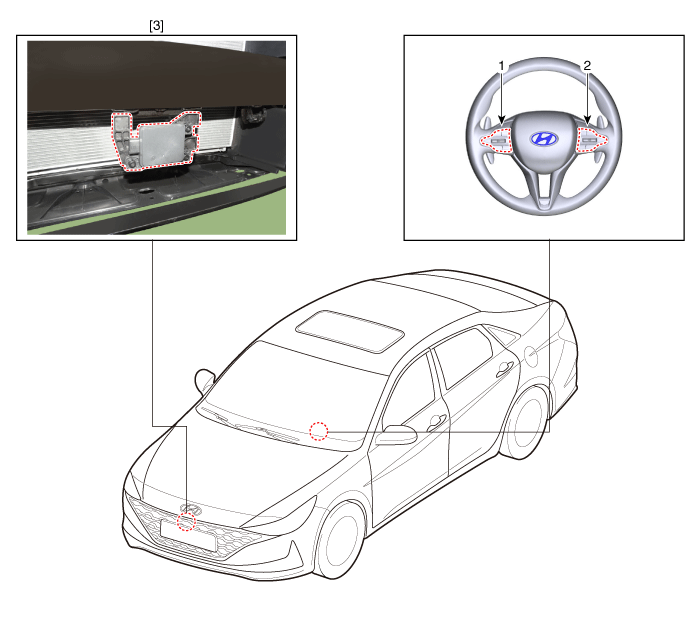
1. Remote control switch (LH : Audio swtich)
2. Remote control switch (RH : Cruse)
| 3. Front rader unit
|
Front Radar Unit
Components and components location
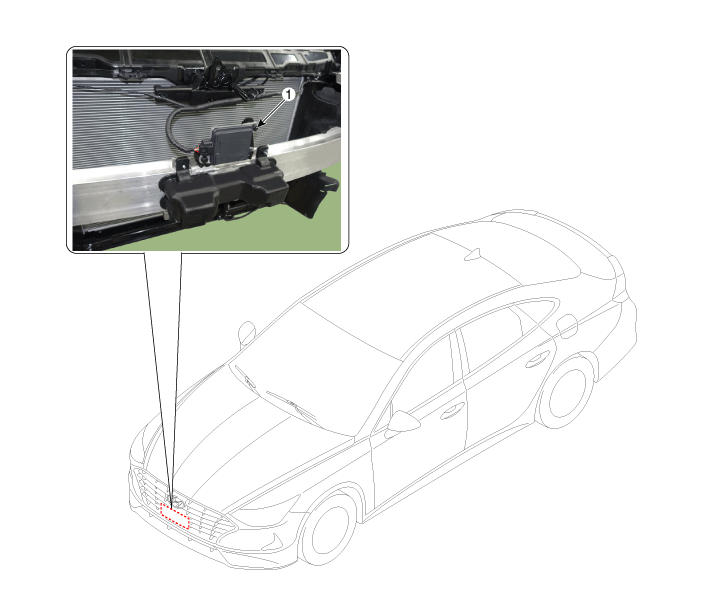
Specifications
Item
|
Specification
|
Power supply (V)
| 12
|
Operation voltage (V)
| 9 - 16
|
Schematic diagrams


Pin No
|
Terminal function
|
1
| GROUND
|
2
| L-CAN HIGH
|
3
| L-CAN LOW
|
4
| C-CAN HIGH
|
5
| C-CAN LOW
|
6
| IGN
|
Repair procedures
Inspection procedure for vehicle with Forward Collision-Avoidance Assist and Smart Cruise Control system failure
| 1. | Check the bumper appearance for accident (check the vehicle appearance visually and see bumper replacement history). → In case of the vehicle was involved in an accident, there is a high possibility that the FCA radar is out of the original default position. |
| 2. | Check for contamination of the radar sensor cover of the bumper. →If contaminated, there is a high possibility that the FCA system is deactivated during operation due to the foreign substances. |
| 3. | After turning on the engine, check the FAC warning lamp and DTC. (Refer to the DTC diagnosis guide.) |
| 1. | Turn ignition switch OFF and disconnect the negative (-) battery cable. |
| 2. | Remove the front bumper. (Refer to Body - "Front Bumper") |
| 3. | Disconnect the front radar connector (A). 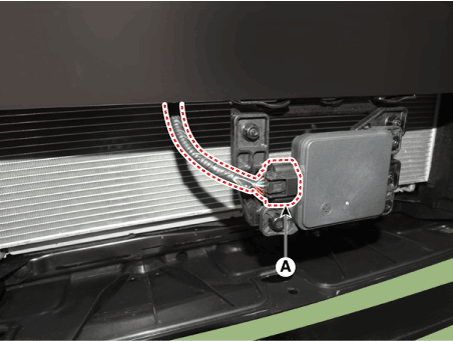
|
| 4. | Remove the front radar (A) from vehicle after loosening mounting nuts. Front radar installation nut : 9.5 - 10.5 N·m (0.97 - 1.07 kgf·m, 7.0 - 7.7 lb·ft) |

|
| •
| Put the vehicle on the level ground. |
| •
| Take out heavy luggage from the vehicles’ seats or trunk. |
| •
| Set all tires according to the specified pressure. |
| •
| Check that the front surface of the front radar is clean. |
|
| 1. | Check the last 2 digits of Lot. No (A) on label at rear side before installing the front radar. | •
| The meaning of Lot. No (A) is the vertical deviation angle of front radar inner side. |
|

|
| 2. | Install the front radar (A) by tightening the nuts. Front radar installation nut : 9.5 - 10.5 N·m (0.97 - 1.07 kgf·m, 7.0 - 7.7 lb·ft) |

|
| 3. | Connect the front radar connector (A) 
|
| 4. | If replaced the front radar with a new one, perform variant coding procedure by using the diagnostic tool. 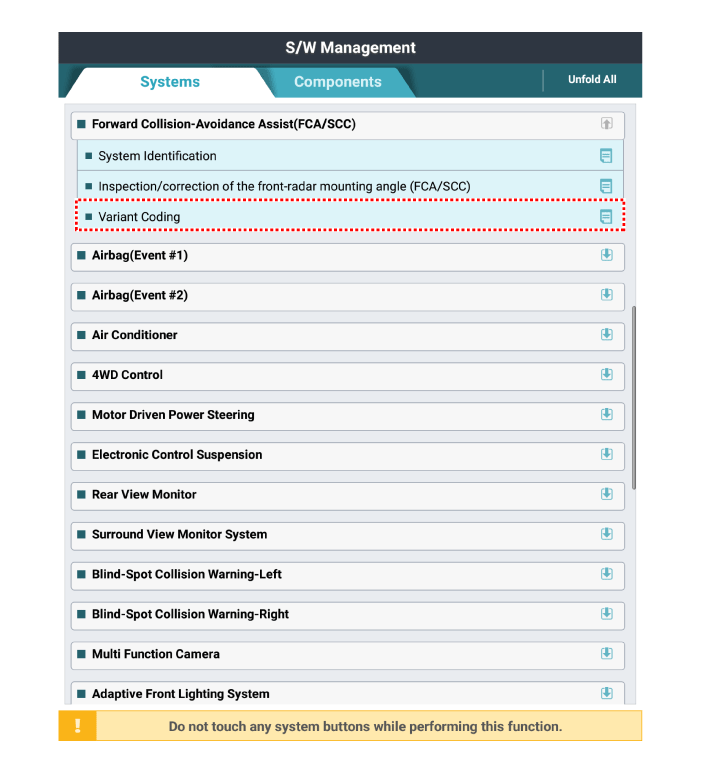
|
| 5. | Check and align the front radar mounting angle. | (1) | Perform the "inspection/correction of the front-radar mounting angle" using the diagnostic tool. 
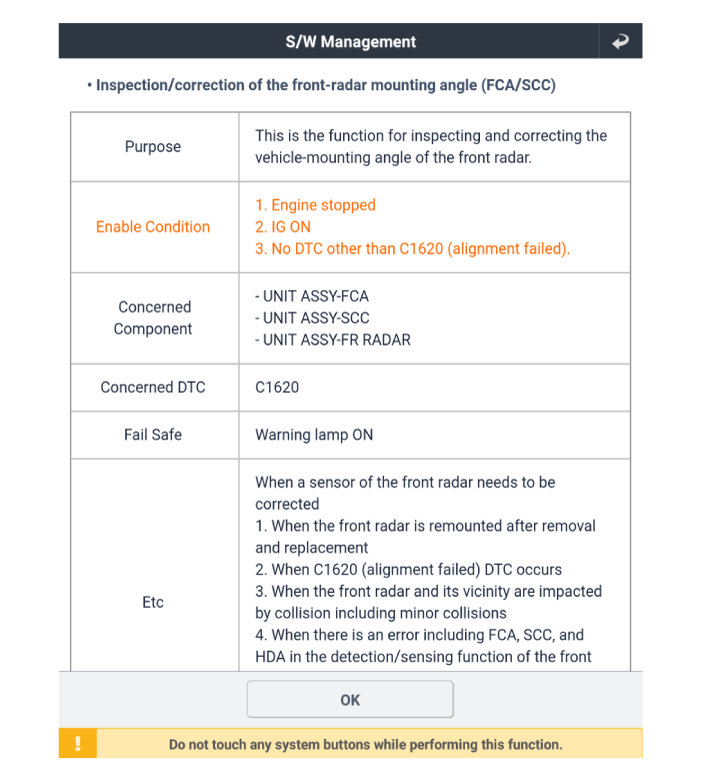
|
| (2) | Input 2 digits of value in the code input box, then press "OK" 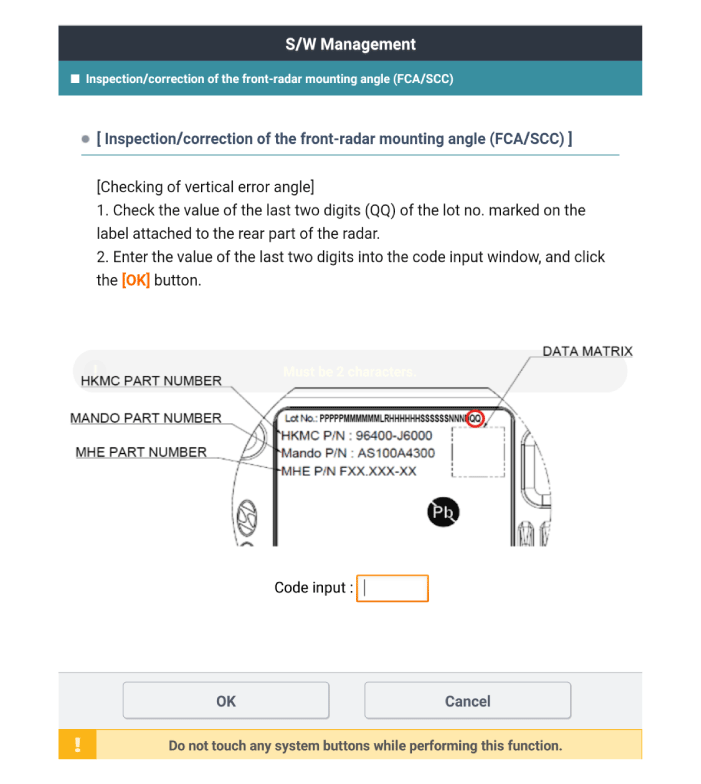
|
| (3) | Check the vertical angle which is compensated error on diagnostic tool. | •
| The result value is final goal vertical angle which is compensated inner error of criteria vertical installation angle -1°. |
|
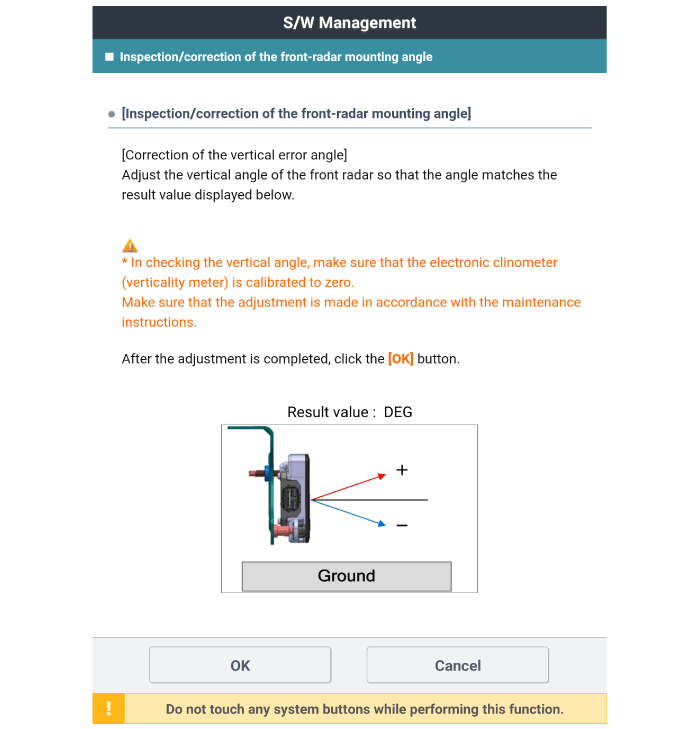
|
| (4) | Check the front radar vertical angle by using the vertical protractor (tiltmeter). | •
| Make sure to perform zero setting before using vertical protractor. (perform this procedure periodically) |
| •
| Be careful with +/- readings when finding true vertical using vertical protractor. |
|
|
| (5) | Adjust to "target vertical angle" by turning adjusting screw of front radar. | –
| turning clockwise : adjusting (+) angle |
| –
| turning counterclockwise : adjusting (-) angle |
| •
| There is a chance to be transformed of bracket if adjusting screw with over strength. |
| •
| Must recheck with vertical protractor if vertical angle is right after adjusting. |
|
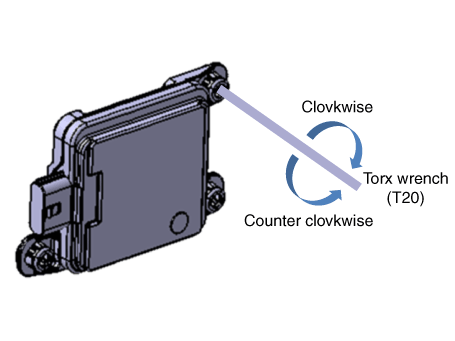
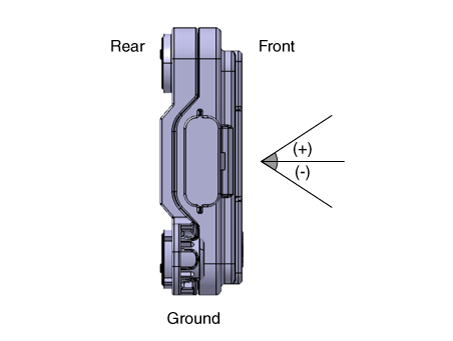
Number of adjustment screw rotation
| Correction angle
| Clockwise
| Counter clockwise
| 0.5
| + 1.1°
| - 1.1°
| 1
| + 2.2°
| - 2.2°
| 1.5
| + 3.3°
| - 3.3°
|
|
| (6) | Install the front bumper assembly. (Refer to Body - "Front Bumper Assembly") |
| (7) | Perform the front radar inspection/correction procedure by using the SST. (Refer to Smart Cruise Control (Stop & Go) (SCC) Unit-Radar - "Adjustment") |
|
FronT Radar Installation Angle Checking / Adjustment Overview
The front radar detects control subject in front, and recognize distance from the subject, comparing speed and etc. For these reasons the direction of installation has to be on collinear with vehicle. Therefore, installing angle inspection and adjustment have to be done in case of the front radar removed and reinstalled caused by accident or install a new front radar. Accuracy of the front radar cannot be guaranteed if inspection and adjustment have not been done in case of mentioned situation before. Front radar inspection/adjustment have to be done with either stop mode (C1) or drive mode (C2) using by diagnostic tool Perform adjustment procedure with exclusive adjustment reflector (SST) for stop mode (C1).
| •
| after operating stop mode, the accuracy will be increased if the vehicle has driven more than 10 min. (drive on straight lane which has metallic reflector.) |
| •
| Operate adjustment on real road driving (drive on the road that has many metallic fixed reflector such as guard rail) for drive mode. (C2) |
|
The cases that front radar installation angle checking/adjustment are needed. | •
| Front radar has been replaced |
| •
| Front radar has been removed and reinstalled. |
| •
| Line up failed DTC has been occurred |
| •
| Failure on front radar detecting and cognition function |
| –
| failed to detect vehicle in front while functioning |
| –
| often detecting error of side lane |
| –
| often detecting error even though any object is not in front |
|
How to Check / Adjust Front Radar Installation Angle - Stop Mode
Preparation before the front radar alignment : | •
| Put the vehicle on the level ground. |
| •
| Take out heavy luggage from the vehicles’ seats or trunk. |
| •
| Set all tires according to the specified pressure. |
| •
| Check that the front surface of the front radar is clean. |
|
| •
| Perform in an area with minimum clearance of 8m (26.2 ft) front, 4m (13.1 ft) sides, and 2 m (6.6 ft) above the vehicle. |
| •
| Install the reflector exactly 2.5 m (8.2 ft) away from the Front Radar. |
| •
| The reflector has to be installed at same place (height and angle) as front radar center. (If height and angle are different, then adjustment can not be done correctly.) |
| •
| Remove objects (metal plates, resins, etc.) that may cause electric signal interference from the area where front radar alignment is performed. |
| •
| Make sure to use exclusive reflector (OK964-J5100) |
| •
| Be sure that the vehicle is not moved and free from vibration when performing front radar alignment (getting in/out or opening/closing doors). |
| •
| IG has to be on when performing front radar alignment. (engine stop condition) |
|
| 1. | Stop the vehicle horizontally at a flat place. 
|
| 2. | Mark the center point (A) after measuring the distance on top of wind glass. 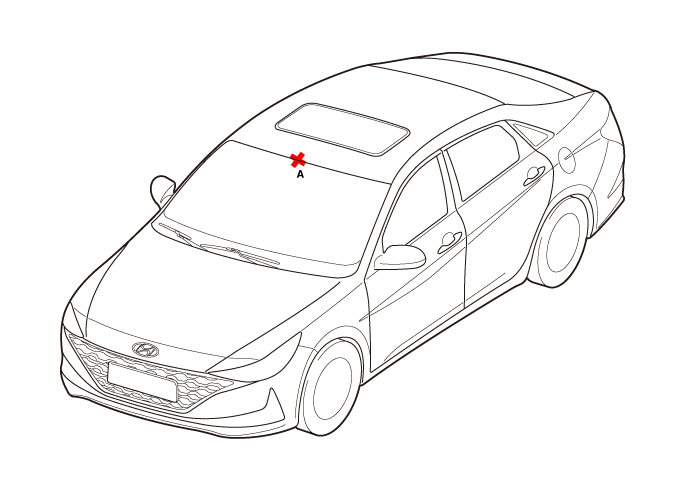
|
| 3. | Mark the center point of emblem (B). 
|
| 4. | Install the laser (09964-C1200) to the tripod (09964-C1300). 
|
| 5. | Place the laser (09964-C1200) at 2.5m (8.2 ft) to the front of the vehicle. 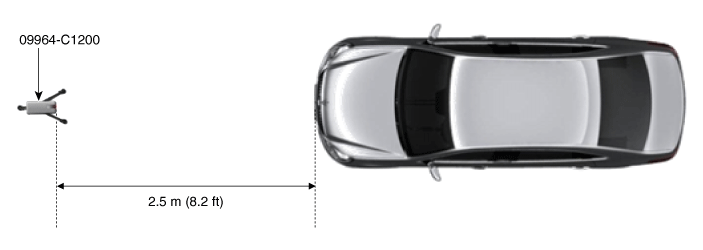
|
| 6. | Match the vertical line of laser to (A) and (B) using the laser (09964-C1200). 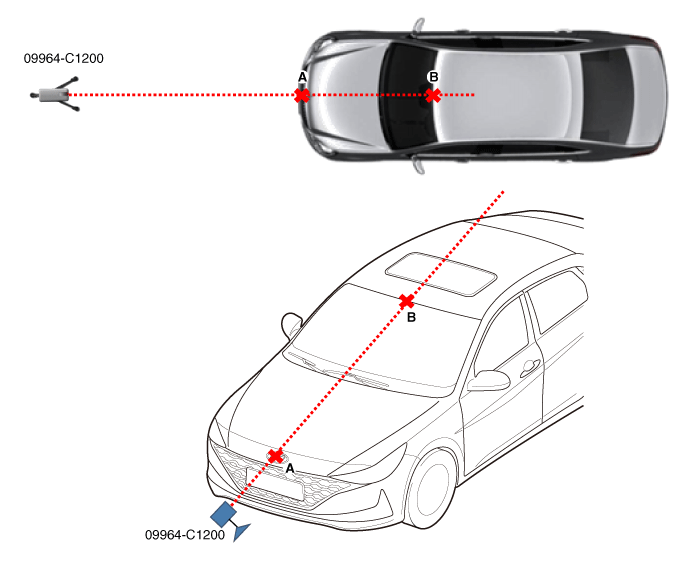
|
| 7. | Mark (C) at 2.5 m (8.2 ft) from (A) in front of the vehicle. |
| 8. | Mark (D) at the place which is 6mm away from (C) to the right in vertical direction. 
|
| 9. | Remove the laser (09964-C1200) from the tripod (09964-C1300). 
|
| 10. | Mount the reflector (09964-C1100) onto the tripod (09964-C1300). 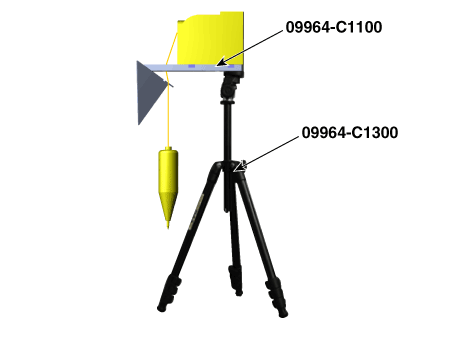
|
| 11. | Mount the reflector adapter (0K964-J5100) to the reflector (09964-C1100). 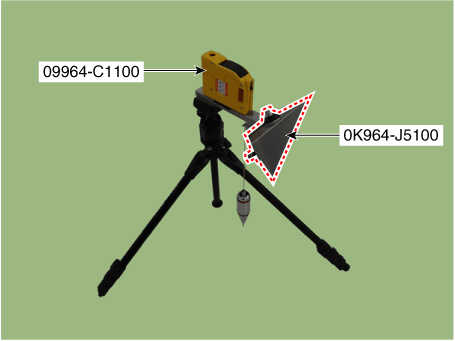
|
| 12. | Set the reflector horizontal using the leveler (A) which is built in the tripod (09964-C1300). 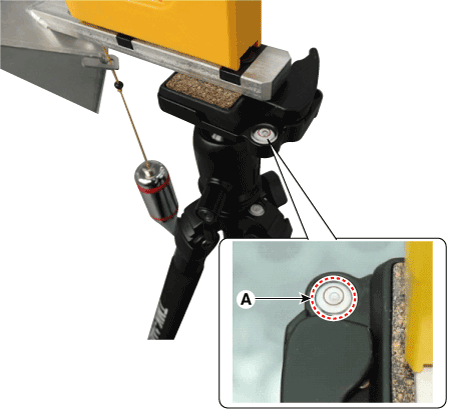
|
| 13. | Align the vertical weight (A) of the reflector (09964-C1100) with the point (D). 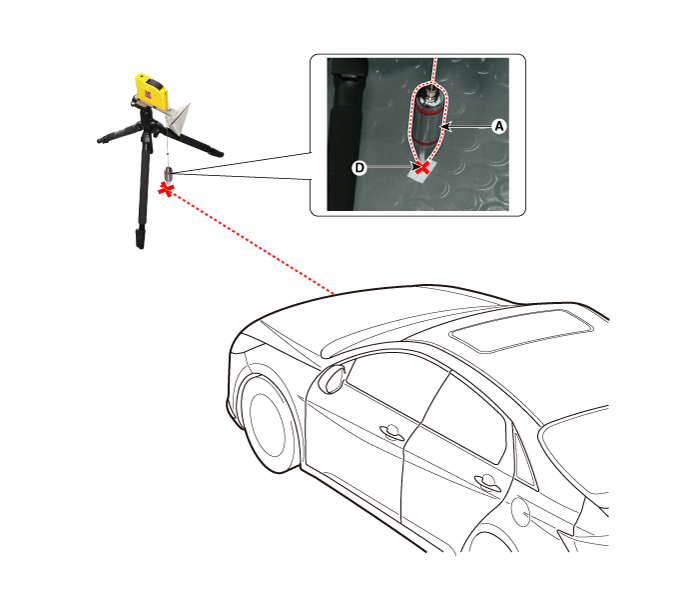
|
| 14. | Set the height of the reflector adapter (0K964-J5100). [General type] 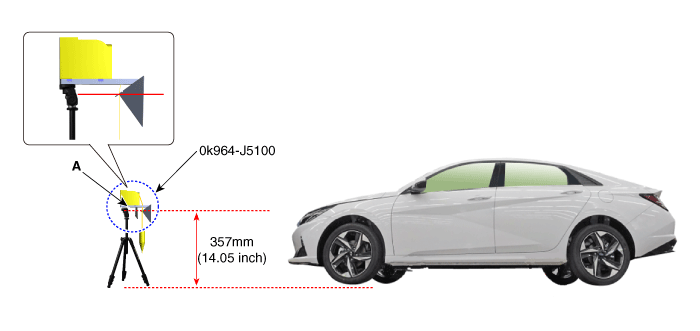
[N Line] 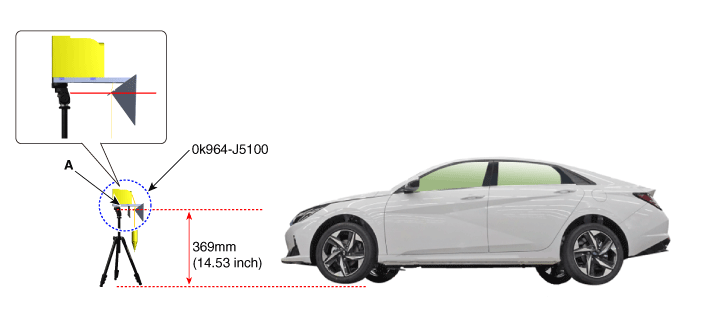
|
| 15. | Remove the vertical weight from the reflector (09964-C1100). | •
| It can be effected to adjustment if the vertical weight is still left. |
|
|
| 16. | Check again the front radar and the surface of front bumper for the following items with the eyes. | •
| Make sure that there is no debris, or reflecting object on the surface of the radar. |
| •
| Make sure that there is no debris, or reflecting object on the radiator grill. |
|
|
| 17. | Select C1 (stop mode) to inspect and adjust the front radar installation angle by following procedure on diagnostic tool screen. 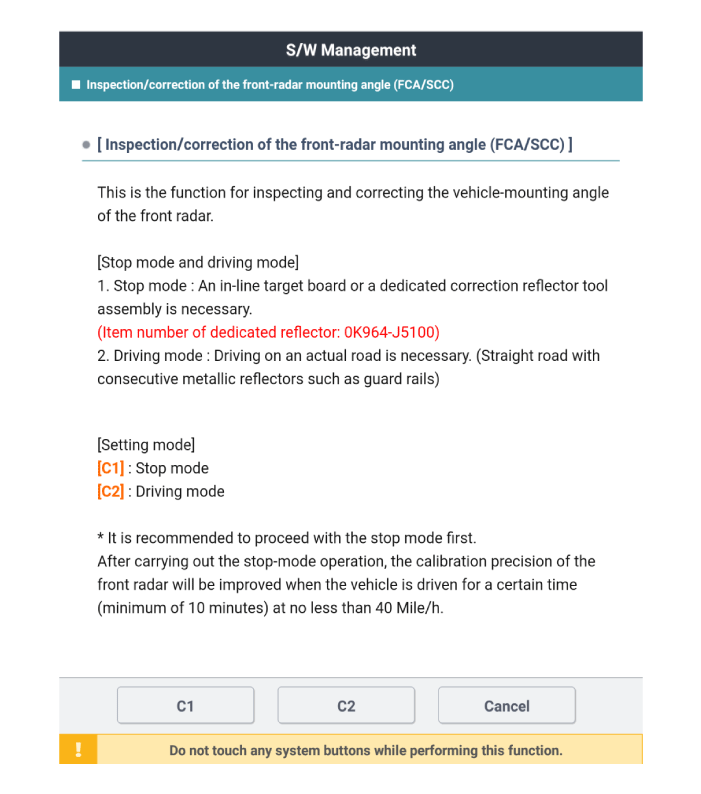
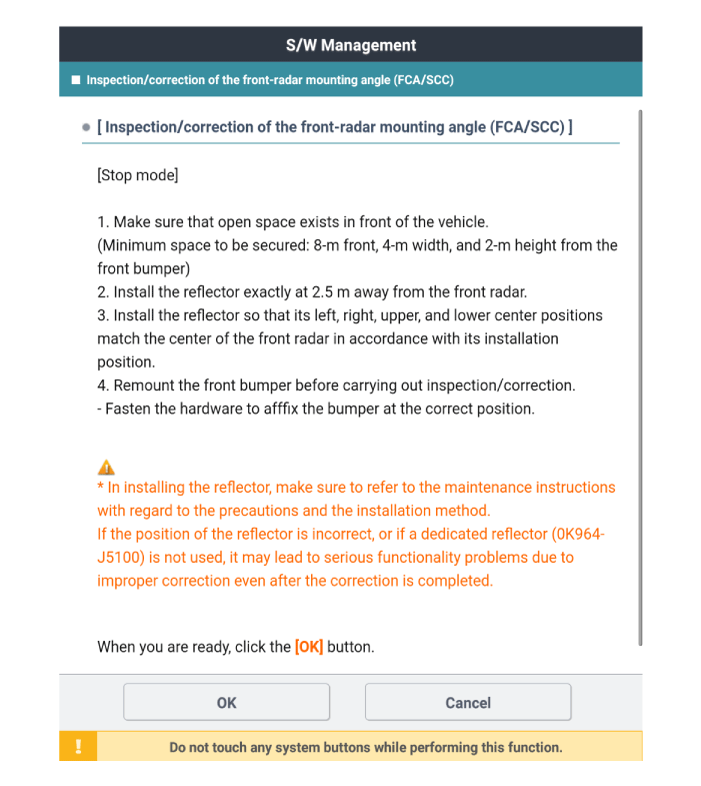

|
How to Check / Adjust Front Radar Installation Angle - Drive Mode
| •
| After operating stop mode, the accuracy will be increased if the vehicle has driven more than 10 min. (drive on straight lane which has metallic reflector.) |
|
If stop mode operation can not be done, then use drive mode to proceed front radar adjusting procedure.
Preparation before the front radar alignment : | •
| Put the vehicle on the level ground. |
| •
| Take out heavy luggage from the vehicles’ seats or trunk. |
| •
| Set all tires according to the specified pressure. |
| •
| Check that the front surface of the front radar is clean. |
|
| 1. | Select C2 (drive mode) to inspect and adjust the front radar installation angle by following procedure on diagnostic tool screen. 
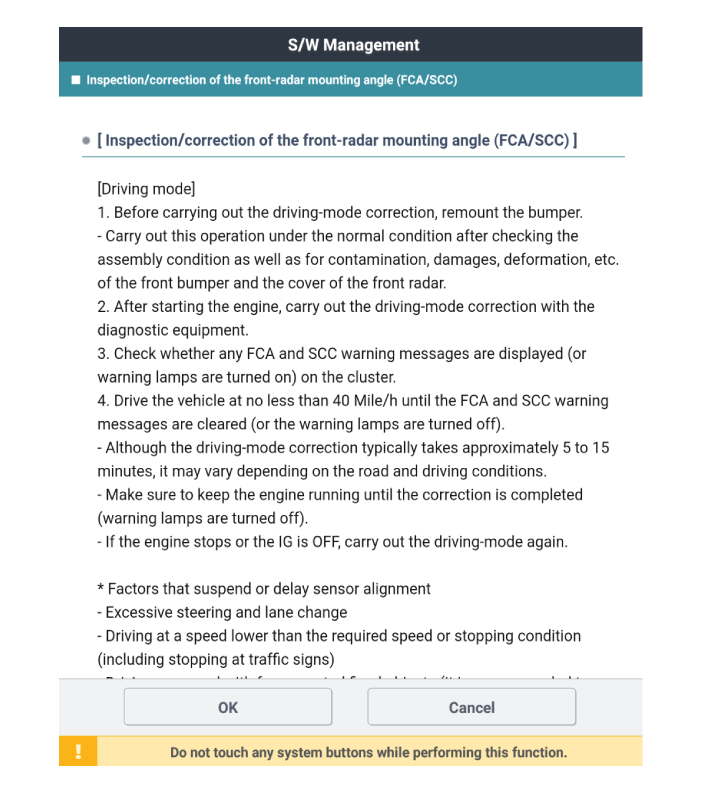
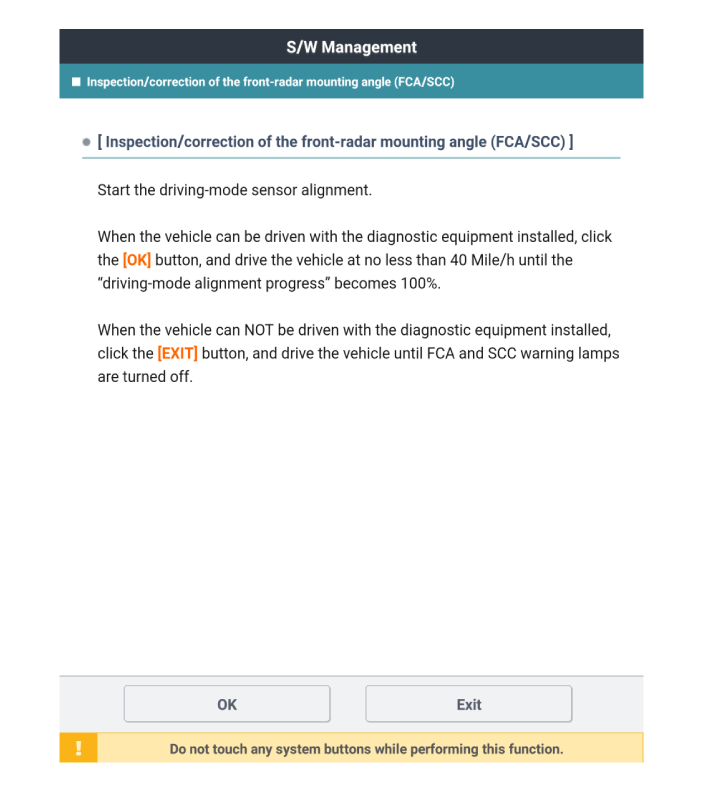
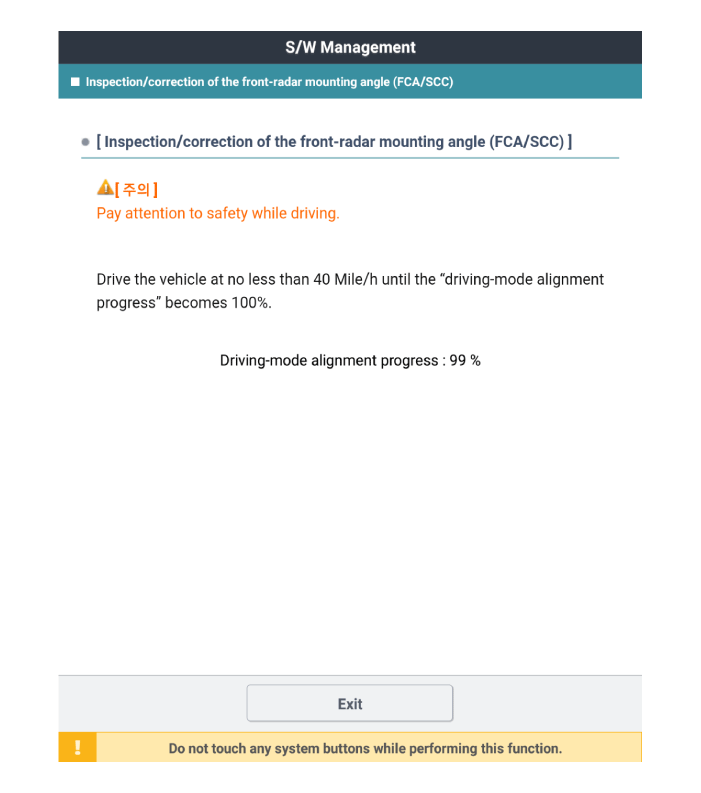
|
| 2. | In case of front radar inspection/correction failure, check the inspection/correction conditions. |
Smart Cruise Control (SCC) Switch
Schematic diagrams
TRIP / SCC / LFA
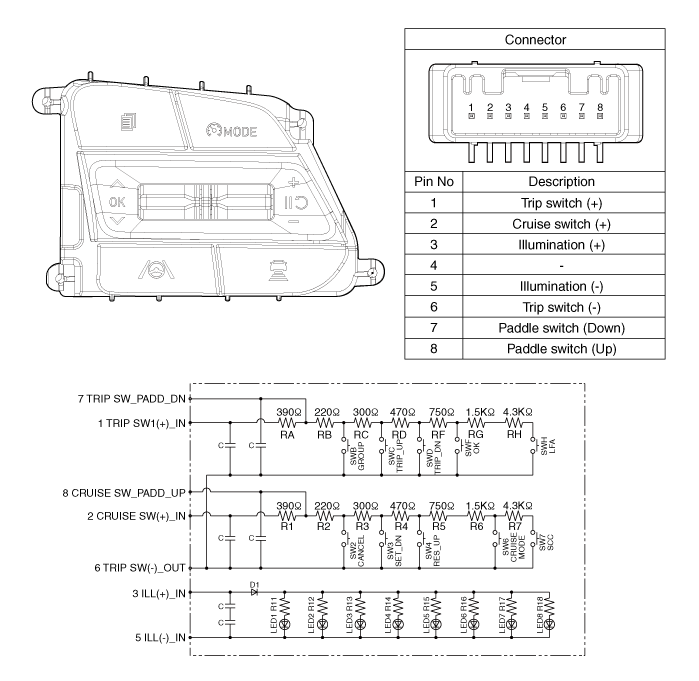
Repair procedures
| 1. | Check for resistance between terminals in each switch position (LH). 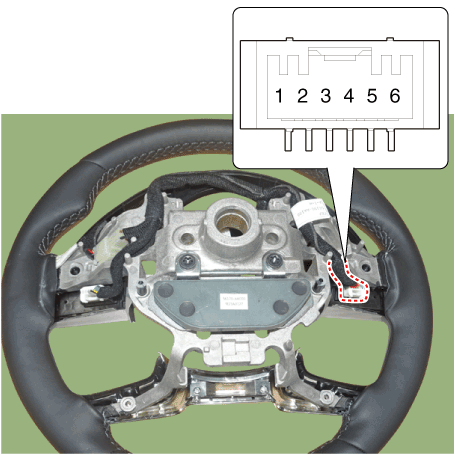
[LH : Audio + Hands free]
Switch
| Resistance (±5%)
| SEEK Up
| 430 Ω
| SEEK Down
| 1.11 kΩ
| MODE
| 2.11 kΩ
| MUTE
| 3.11 kΩ
| Volume (+)
| 4.61 kΩ
| Volume (-)
| 6.81 kΩ
| Voice
| 10.71 kΩ
| SEND
| 18.91 kΩ
| END
| 40.91 kΩ
|
|
| 2. | Check for resistance between terminals in each switch position (RH). 
[Cruise]
Switch
| Resistance (±3%)
| Paddle shift (Up)
| 390 Ω
| Cruise CANCEL
| 610 Ω
| Cruise SET&Speed down
| 910 Ω
| Cruise RES&Speed up
| 1.38 kΩ
| Cruise ON/OFF
| 2.13 kΩ
| Cruise speed limit ON/OFF
| 3.63 kΩ
| SCC distance adjustment
| 7.63 kΩ
|
[Trip]
Switch
| Resistance (±3%)
| Paddle shift (Down)
| 390 Ω
| Trip group/Trip
| 610 Ω
| Trip (Up)
| 910 Ω
| Trip (Down)
| 1.38 kΩ
| OK
| 2.13 kΩ
| BACK
| 3.63 kΩ
| LFA
| 7.93 kΩ
|
|
| 1. | Disconnect the negative (-) battery terminal. |
| 2. | Remove the steering wheel assembly. (Refer to Steering System - "Steering Wheel") |
| 3. | Remove the steering back cover (A). 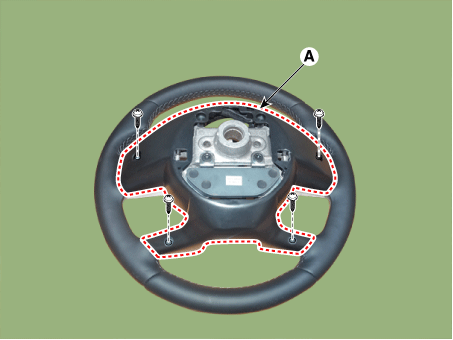
|
| 4. | Remove the steering remote control connector (A). 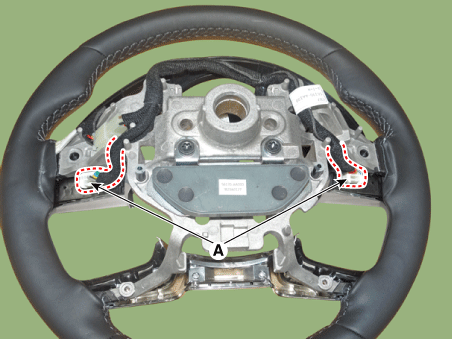
|
| 5. | Remove the steering remote control(Switch (A)) after loosening the screws. 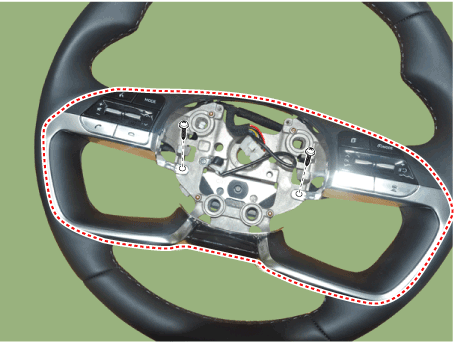
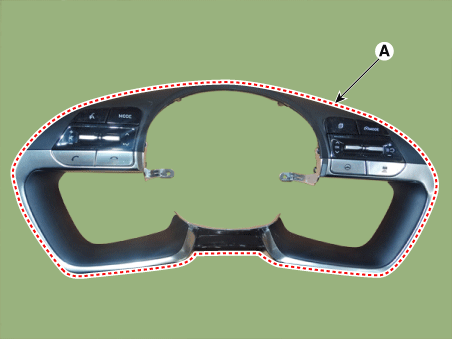
|
| 1. | Install the steering wheel remote control after connecting the connector. |
| 2. | Install the steering wheel. |
| 3. | Connect the negative (-) battery terminal. |
Description and operation
Description and OperationBlcok Diagram
•
This system monitors the driving situations through the radar and the camera. Thus, for ...
Description and operation
DescriptionThe cruise control system is engaged by the cruise "ON/OFF" main switch located on right of steering wheel column. The system has the capability to cruise, coas ...
 Hyundai Elantra CN7: Front Radar System
Hyundai Elantra CN7: Front Radar System




























































